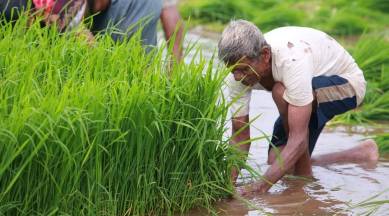Stay updated with the latest - Click here to follow us on Instagram
Maharashtra: Foodgrain sowing shrinks but oilseed farming rises in kharif season
The foodgrain area has declined from 54.75 lakh hectares to 49.79 lakh hectares, whereas the oilseeds area grew 5.4% to 51 lakh hectares.

As of September-end, kharif sowing across Maharashtra recorded a minuscule rise from 145.42 to 146.86 lakh hectares, but the sowing of foodgrains saw a 9.05 per cent decline, according to the agriculture department.
The area with foodgrain farming this season has come down to 49.79 lakh hectares from 54.75 lakh hectares last year. The data is based on crop-wise reports from the districts for paddy, jowari, bajri, ragi, maize, tur, moong, udit, chawli and rajma.
monthly limit of free stories.
with an Express account.
The shortfall is mainly in jowari, which is sown in 1.42 lakh hectares, down from 2.08 lakh hectares last year. And bajri sowing fell to 4.07 lakh hectares from 5.04 lakh hectares. Paddy, essentially grown in parts of Konkan and eastern Vidarbha, has remained constant at 15 lakh hectares. The area of ragi farming has shrunk from 73,369 hectares to 68,612 hectares. Maize is slightly better at 8.80 lakh hectares compared with last year’s 8.72 lakh hectares.
However, the area under oilseed cultivation has shown a remarkable increase of 5.4 per cent—from last year’s 48.37 lakh hectares to 51 lakh hectares.
Sources in the department attributed higher returns, coupled with aggressive national and state campaigns to reduce the import dependence, to the growth in the sector.
The main oilseeds grown in the state are bhuimoong, sesame, sunflower, soybean, karal. Soybean is the main kharif crop cultivated in the Vidarbha and Marathwada regions. At least 45-50 lakh farmers depend on income from the crop. As against last year’s 46.05 lakh hectares, the area under soybean cultivation is spread over 49.09 lakh hectares—6.61 per cent more than last year.
A secretary in the department said, “Soybean has fetched higher returns over the past two years. As a result, more farmers are dependent on soybean. While the minimum price for soybean is Rs 4,300 per quintal, the best-quality variety fetches as much as Rs 7,500.”
However, department officials fear the erratic and intense rainfall may take a toll on the quantity and quality of soybean this season.
As per a primary report, crops in 12-15 lakh hectares suffered damage in rain. But final panchanamas are not completed, according to department officials. Several parts of the Vidarbha, Marathawada, north and western Maharashtra, and Konkan regions reported rain-related natural calamities, including during the second and third sowing between July and September.
Although the monsoon season ends in September, the India Meteorological Department has predicted intermittent rainfall till October-end.
With three consecutive good monsoons, which have ensured surplus water, farmers have also turned to sugarcane cultivation. The area under sugarcane plantation has grown substantially from last year’s 2.71 lakh hectares to 3.77 lakh hectares.
Similar is the trend in cotton. The white gold, as it is known, is a cash crop essentially grown in the Vidarbha and Marathwada regions. This kharif season, cotton is cultivated in 42.29 lakh hectares, up from 39.57 lakh hectares last year.
At the minimum support price of Rs 6,080 per quintal, farmers have to ensure the production and quality are not marred by the frequent spells of rain that have cast a shadow on the prospects.